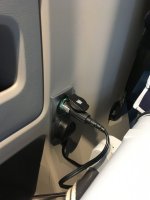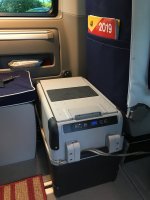mr_glasgow84
Thanks Tarquers, much appreciated.
Buy all your VW California Accessories at the Club Shop Visit Shop


This is how I have my fridge set up at present with two cables. I plan to get solar power, hard wire it as per @Amarillo's description. Then hopefully a 12v extension cable made from 6mm^2 automotive cable will work out in the awning...
Two pictures below - hope this helps clarify things in your mind
Top one is of the two cables that came supplied with the fridge, the 12v one is plugged into the 12v socket and the 240v 'kettle' lead into the 3pin 240v socket.
If on hook up, then the fridge uses the 240v supply, but automatically switches to 12v when the 240 volt supply is disconnected.
View attachment 42758
View attachment 42759
If hooked up the length of power cable from 12 volt socket to fridge is highly unlikely to matter as the voltage at the power socket will be a steady 13.8 volts.
Tom, sorry but you still need to edit your post. Type B fridges last a lot longer than 'a few hours'. Ours last a few days.for more than a few hours.
maybe some need 1,25mm2 cable at 10 metersOoo that is wrong?
On hookup the leisure socket voltage should not be below 13.8 volts.
I recall couple stormy nights in Norway with waterfalls and rivers noisy as a thunder. My wife climbed down and hugged the freezer which as she said calmed her with purring noise in her sleep.In my case, if the fridge made a noise at night, I think my wife would want to move it to the awning.
The Waeco 29L coolbox is 5 amps max. At max setting it would flatten an 80Ah battery in 16 hours
I've deleted my posts in this thread. They were based on my experiences of cheap cool boxes ~18 years ago, so were outdated.Why do you insist on writing drivel ?
Maybe its lost in translation but you could surely disagree or call something out without being so insulting?Why do you insist on writing drivel ?
Sorry that's just rubbish...A picnic box which helps keep stuff sort of coolish/lukewarm for a few hours...
Sorry that's just rubbish...
You may be very happy with your expensive Waeco or whatever you have but that doesn't mean you should give opinions masquerading as facts. Really not sure what benefit anyone can derive from statements like that.
Thermo-electric coolboxes cool to 20C below ambient - not what you might call lukewarm for normal use. Or maybe Devon normally averages 40C throughout the year.
Anyway, there's no need to diss things that you don't like...
Point of order there Matt.Maybe its lost in translation but you could surely disagree or call something out without being so insulting?

1-compressor fridge 12v/24v or 240v
2- absorption fridge 12v, 240v or log
3- coolbox 12v/24v usually fan driven
Admitting a mistake is hardly a display of arrogance.The arrogance of the man.
Sorry but exactly that. Just advertized on paper. It won't do even 5'c below with 0 outside.Sorry that's just rubbish...
Thermo-electric coolboxes cool to 20C below ambient -

The VW California Club is the worlds largest resource for all owners and enthusiasts of VW California campervans.

